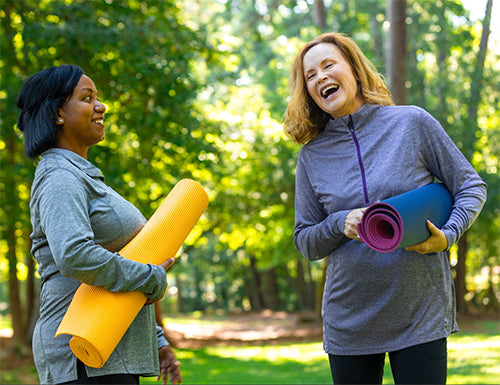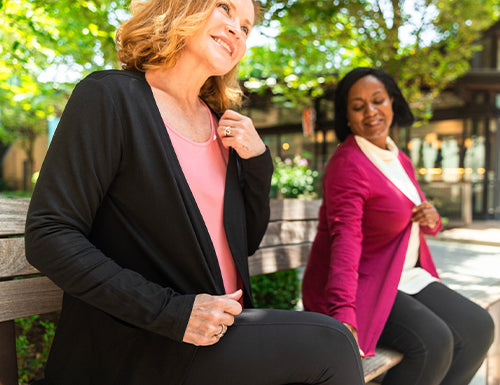The holidays are rapidly approaching. While that means spending more time with loved ones and the opportunity to enjoy your favorite hot drinks by the fire, for many people the holidays are a time of heightened stress. Organizing gatherings, finding the perfect gifts for all the kids and grandkids, and the fact that November snuck right up on us can lead us to feeling stressed, getting thrown out of our normal routines, and losing sleep over all there is to do in the next two months.
Keeping up with your routines is important, and making sure you dedicate time to yourself each day to breathe, journal, or do some restorative yoga at home can keep your stress levels down and help you sleep better.
85% of people who do yoga say that it helps them reduce their stress levels, and 55% connected doing restorative yoga to getting a better night’s sleep. If you’ve ever fallen asleep in a yoga class, you know how relaxing it can be! Yoga helps the body slow down, especially when you combine your poses with deep, focused breathing. And you don’t have to be a yogi or commit yourself entirely to the practice - a few poses in your bed or on a mat on the floor for 5-10 minutes at night can leave you feeling relaxed, limber, and more energized when you wake up. Here are three of our favorite restorative yoga poses to help you get a more restful and deep sleep.
Pose 1: Child’s Pose
The child’s pose is one of our favorite yoga poses, because it releases a lot of tension in the lower back. Start by kneeling (either on your bed or on a floor mat), and lean back so you are sitting on your heels. Make sure your knees are slightly apart, and then slowly fold forward as you exhale, so that your torso is in between your thighs. Tuck in your chin slightly so that you’re not straining your neck. From there, you can either let your arms stretch out in front of you (this is the extended child’s pose), or let them go down at your sides, so that your hands are near your feet. Stay in this position for as long as you feel comfortable, and make sure that you are focusing on your breath.
Modified: If you feel as though folding yourself in half so that your chest touches the floor is too strenuous on your back or knees, you can use pillows for extra support. As you are kneeling, place the pillow between your knees, so that when you fold forward you are almost hugging the pillow with your body. You can also place a pillow behind you so that you are sitting on it as opposed to sitting on your heels, which can be helpful for anyone experiencing knee pain.
Post 2: Butterfly Pose
The butterfly pose helps to stretch your hips and inner thighs. Many people may already know this pose as being a pre-workout stretch, but it is a great beginner’s restorative yoga pose that doesn’t require any additional equipment like blocks or bolsters. Sit up straight, and bring your legs in so that the soles of your feet are touching one another. Hold onto your feet if you can reach, and begin to move your folded legs up and down as if they were wings of a butterfly. The closer you tuck your feet into your groin, the more stretch you’ll get in your inner thighs, and holding onto your feet stretches out your arms and back. Do this for about 20-30 seconds or as long as you feel comfortable, while taking deep breaths to release any tension you are feeling.
Modified: It can be difficult sometimes to fold in a way that allows your feet to touch. You don’t have to bring them all the way in, or you can sit “criss-cross applesauce” if it feels more comfortable. Or, you can bring one leg in at a time while the other leg stays straight, and alternate after 20 seconds. Also, don’t try to force your knees to touch the ground as you stretch - this can do more harm than good. Yoga is about feeling good and relaxing; if you can’t do a pose exactly as it is shown online, don’t let that discourage you! After all, there are modifications for a reason.
Pose 3: Reclined Twist
This pose is another that is great for stretching out your back as you lay down. It might be better to do this on the floor rather than your bed, only because the bed might be too soft for you to get a decent stretch. If you’re not worried about getting a deep stretch, though, the bed is fine. Start by laying on your back with your legs bent at the knee and your feet touching the floor. Pull your legs in towards your chest, and then let your arms go straight out at your sides. Let both of your legs fall to one side, making sure that your shoulders stay on the ground and that your upper back is flat. You are essentially twisting your torso here; this eases spine tension, stretches your chest and shoulders, and can even help you with digestion. Take 5 deep breaths in and out, and then switch positions so that your legs go to the other side. After your 5 breaths, you can straighten out and let your feet touch the ground again.
Modified: If your shoulders don’t stay flat against the floor or you feel like you can’t bring your legs up enough, no worries! Focus on twisting your back as much as you feel comfortable doing, and focus on your breathing.
Restorative yoga is all about feeling relaxed and balanced. If you stress yourself out about not doing a pose “the right way”, then you’re defeating the whole purpose. Do as much as you feel comfortable doing, and remember to focus on your breath. If you don’t feel ready for yoga, finding breathing techniques to relax can also aid in a more restful sleep. Also, YouTube is full of guided yoga and meditations for sleep.
Take advantage of anything and everything that’s out there, and try to find something that is right for you. There are videos based on what kind of equipment you have, how much time you want to spend on your yoga routine, and how experienced you are. You can also find yoga for specific issues, such as anxiety relief, improved energy in the morning, and even problems with bloating and digestion. Finding a routine to keep yourself feeling good and well rested is so important during the holidays (and the cold and flu season). Stay happy and stay healthy!




